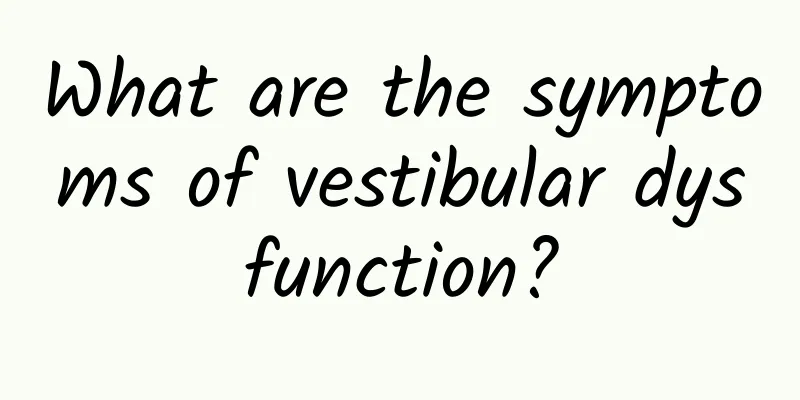What are the symptoms of vestibular dysfunction?

|
Vestibular function plays an important role in the human body, so people need to always pay attention to relevant examinations to avoid the situation where symptoms occur but it is too late. Vestibular dysfunction can cause many adverse effects on the human body, and different treatments need to be chosen according to one's health condition. The main symptoms of vestibular dysfunction are dizziness and nystagmus. The types of nystagmus are divided into horizontal, rotational, vertical, oblique and mixed types. The intensity is also divided into levels one, two and three. Timely examination can allow early treatment. Following the doctor's advice can help you get rid of functional disorders and restore your health. 1. Main symptoms Vertigo can be caused by inner ear diseases, central nervous system diseases, and many systemic diseases. Inner ear diseases such as labyrinthitis and Meniere's disease. Central nervous system diseases such as acoustic neuroma, temporal lobe tumors, etc. Systemic diseases such as hypertension, hypotension, arteriosclerosis, autonomic nervous system dysfunction, etc. Vestibular function tests are of great value in distinguishing these diseases. However, a diagnosis cannot be determined by just one vestibular function test. Two or more vestibular function tests are needed, and the results are comprehensively analyzed, combined with medical history, physical examination, neurological examination and various tests to make an accurate diagnosis. 2. Nystagmus An involuntary, rhythmic reciprocating movement of the eyeballs consisting of a slow phase and a fast phase. The slow phase is the slow rotation of the eyeball in a certain direction, and the fast phase is the movement of the eyeball quickly returning to its original position after the slow phase. The fast phase is usually assigned to the direction of the nystagmus. Types of Nystagmus It is divided into horizontal type, rotational type, vertical type, oblique type and mixed type (such as horizontal rotational type). 4. Nystagmus Intensity It is divided into grades: Grade ① nystagmus. Nystagmus occurs with gaze in only one direction (left or right, usually the fast phase of nystagmus). Grade ② nystagmus. Nystagmus occurs both in one direction and when looking straight ahead. Grade ③ nystagmus. Nystagmus occurs with gaze in all directions, including the direction of the slow phase of nystagmus. Sometimes the nystagmus is too subtle to be seen with the naked eye. In order to observe the nystagmus carefully and clearly, the subject can be asked to wear Frenzel glasses, which will magnify the nystagmus and make it easier to observe. 5. Production Mechanism There is a functional connection between the ampulla of each semicircular canal and the two sets of extraocular muscles. The ampulla of the superior semicircular canal is connected to the superior rectus muscle on the same side and the inferior oblique muscle on the opposite side, the ampulla of the posterior semicircular canal is connected to the superior oblique muscle on the same side and the inferior rectus muscle on the opposite side, and the ampulla of the lateral semicircular canal is connected to the medial rectus muscle on the same side and the lateral rectus muscle on the opposite side. At the same time, the superior, inferior and medial vestibular nuclei send fibers to the medial longitudinal fasciculus, which connect with the nerve nuclei of the eye muscles, thus establishing a reflex arc. This reflex arc can cause the eye muscles to produce a reflex response to the input impulses from the vestibule and semicircular canals, namely nystagmus. Therefore, when there is a lesion in the vestibular labyrinth (such as Meniere's disease) or when doing hot and cold water tests, the semicircular canals are stimulated and nystagmus occurs. When checking nystagmus, ask the subject to look at the examiner's index finger moving slowly in all directions. The finger is about 50 cm away from the patient's eyeball. The subject's gaze angle (the angle where the line of sight intersects the midline) should not exceed 45°. If it exceeds 45°, it may induce physiological terminal nystagmus and affect the accuracy of the examination. The finger moves in four directions: left, right, up and down. If necessary, move diagonally to the upper right and lower left, and the upper left and lower right. |
<<: Cervical lymphoma has these symptoms, early detection and early treatment
>>: How long does it take for pancreatic function to recover?
Recommend
Conditions for vaginal delivery after cesarean section
We all know that because of the implementation of...
The best way to treat tinea pedis, traditional Chinese medicine remedies to say goodbye to athlete's foot
Tinea pedis, which is commonly known as athlete&#...
How to clear the lungs after smoking too much? Chinese medicine recommends a lung-clearing diet
We know that it is harmful to health, especially ...
Chest pain before menstruation
Many girls experience breast distension or stomac...
Can I swim if I have a urinary tract infection?
Swimming is a very popular sport. It can effectiv...
Foot bath weight loss method, Chinese medicine foot bath weight loss foot bath recipe
We all know that foot soaking is a good way to ma...
Redness, swelling and pain after skin friction
If redness, swelling and pain occur after a heavy...
Kidney function tests
The kidneys are important organs in the human bod...
Does zinc gluconate treat acne?
Zinc gluconate is a common oral solution for zinc...
What medicine should I use for dry and cracked heels?
I believe that many people have experienced dry, ...
There may be a reason why yellow urine has an odor. What should you do if your urine has an odor?
Many people think that yellow urine with a strong...
What to do if the elderly have blood clots in their legs
Leg blood clots are a common symptom in the elder...
What anti-inflammatory drugs should I take for viral infection?
Viral infection is actually a situation in which ...
What are the causes of thoracic spine pain?
Thoracic spine pain is a common disease in our li...
Why are Chinese people more and more likely to get cancer?
In the past decade or so, cancer has been like an...









